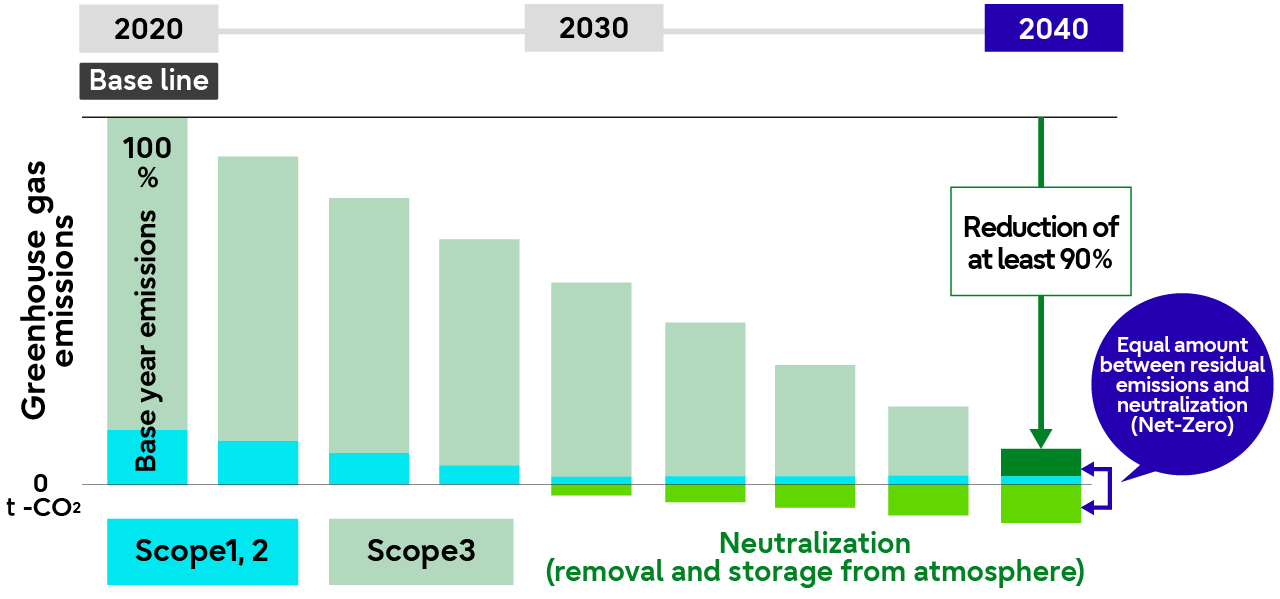The Fujitsu Group Environmental Vision
The Fujitsu Group has reassessed its social responsibility in light of the escalating global commitment to achieving carbon neutrality. The Group has set clear targets: to reduce the greenhouse gas emissions of its own operation (Scope 1 and 2) to be ‘net-zero ready’ by FY2030, and to reach net-zero greenhouse gas emissions(*1) across its entire value chain by FY2040, thus taking strong steps towards achieving a sustainable future.
*1: Net-zero greenhouse gas emissions : Achieving a state where greenhouse gas emissions are reduced by at least 90% in the target year in comparison to the base year, and neutralized the residual emissions (of 10% or less) by removing them permanently from the atmosphere through technologies such as Direct Air Capture (DAC) or by afforestation.
The Importance of Responding to Climate Change
The Intergovernmental Panel on Climate Change (IPCC) Special Report “Global Warming of 1.5°C“ articulated the need to limit warming to 1.5 °C above pre-industrial levels and to achieve carbon neutrality by 2050. With social roles expanding and additional demands placed on companies to tackle climate change, in October 2021 the Science Based Target Initiative (SBTi) (*2) launched the world’s first Net-Zero Standard for companies to set net-zero strategies.
In order to resolve issues related to climate change, the Fujitsu Group decided to revise its previous commitment to "zero CO₂ emissions by 2050", pursuing instead a more ambitious vision that requires the Group to look beyond social trends and become the very embodiment of a leading SX company that delivers carbon neutrality.
The Fujitsu Group Environmental Vision comprises three pillars, namely, Value chain: Achieve net-zero emissions, Mitigation: Contribute to a carbon-neutral society, and Adaptation: Contribute to climate change adaptation measures. The Fujitsu Group will be quick to leverage advanced Digital transformation (DX) technologies to tackle its own net-zero strategies, and will make the resulting expertise available as Fujitsu Group solutions for customers and society. In so doing, the Group aims to leverage its own business activities to contribute to climate change mitigation and adaptation.
*2: Science Based Target Initiative (SBTi) : An initiative jointly established by the United Nations Global Compact, the World Resources Institute (WRI), and other organizations in 2015. It encourages companies to set GHG emission reduction targets consistent with science-based evidence to the level required by the Paris Agreement, validating targets that comply with criteria including indirect emissions not only within the company but also in the supply chain.
Concept : Three pillars of the Fujitsu Climate and Energy Vision



Achieving Net-zero Emissions in the Fujitsu Group Value Chain
In June 2023, Fujitsu obtained Net-Zero Target validation, a standard for global climate change measures, from SBTi. The Group is making progress towards its ambitious targets of achieving net-zero emissions from the Group’s business activities by FY2030, and from the entire value chain by FY2040. To accelerate the move toward carbon neutrality, and contribute to the realization of a sustainable society, the Group is expanding its introduction of renewable energy, among other initiatives.
Roadmap to Net-Zero

FY2030 targets
- Scope 1+2 emissions to net zero equivalent (compared to FY2020)
- Scope 3 emissions reduced by more than 25% (compared to FY2020)
Contributing to a Carbon-neutral Society
The Fujitsu Group contributes to the decarbonization of society by creating ecosystems with customers in a variety of industries and business types. DX is crucial to achieving this goal. By integrating advanced AI and other leading-edge digital technologies into a framework that transcends business, industry, and regional boundaries, the Group will reduce greenhouse gas emissions. This will be achieved through, for example, the optimal use of resources and energy across all social systems.
Contributing to Climate Change Adaptation Measures
We will leverage advanced forecasting technologies, incorporating sensing, high-performance computing (HPC) simulations, AI, advanced ICT and other digital technologies to effectively reduce greenhouse gas emissions. These technologies will be used to develop solutions for building resilient social infrastructure, ensuring a stable supply of agricultural products, and mitigating food loss. Through these efforts, we aim to minimize the harm caused by climate change to society and our customers.


